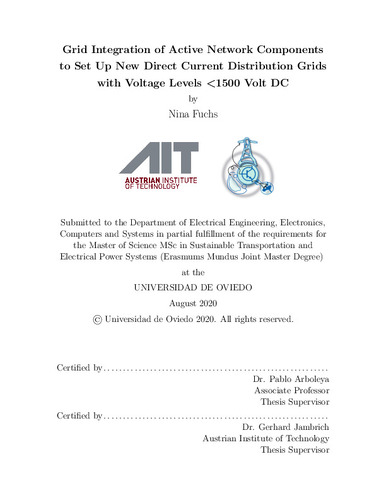Grid Integration of Active Network Components to Set Up New Direct Current Distribution Grids with Voltage Levels <1500 Volt DC
Autor(es) y otros:
Director(es):
Palabra(s) clave:
Hybrid AC/DC Low-Voltage Grids
Fecha de publicación:
Serie:
Máster Erasmus Mundus en Transporte Sostenible y Sistemas Eléctricos de Potencia
Descripción física:
Resumen:
Direct current (DC) has several well-known advantages over alternating current (AC), but since DC transformation was only made possible by the introduction of semiconductors, AC had won the War of Currents in the late 19th century. Nowadays, DC can be efficiently transformed using converters; the advantages of DC stay, while the biggest disadvantage disappeared. Furthermore, DC seems to be the environmentally friendly way to integrate the loads of the future in the low voltage distribution grid (LVDG) thanks to the reduction of conversion stages. This thesis analyses the differences between DC and AC in the context of LVDG lines and feeders. In a simple line model simulation, the advantages of lines operated in DC are verified. It was confirmed that the transmission capacity can be increased significantly by using DC at 1500 V, while very long distances can be achieved due to the reduced line losses. The model was applied to a synthetic test grid, where low voltage feeders were converted from AC to DC. In hybrid AC/DC simulations of the test grid, it has been shown that overloading and voltage violations caused by the integration of electric vehicles (EV), photovoltaic systems (PV) or increased energy demand can be mitigated by converting the concerned feeder to DC. The grid benefits from reduced voltage fluctuations, while the newly integrated active network components can be used for active and reactive power control on the AC side. A web interface was developed, allowing customisable AC, DC and AC/DC hybrid simulations of simple line and LVDG grid models in PowerFactory. The results are presented in interactive plots and the user can apply financial models on the simulation results. The economical findings indicate that the implementation of DC can be even financially beneficial, especially when future development of DC technologies is considered. This diploma thesis was developed as part of an internship at the Austrian Institute of Technology (AIT) GmbH in Vienna.
Direct current (DC) has several well-known advantages over alternating current (AC), but since DC transformation was only made possible by the introduction of semiconductors, AC had won the War of Currents in the late 19th century. Nowadays, DC can be efficiently transformed using converters; the advantages of DC stay, while the biggest disadvantage disappeared. Furthermore, DC seems to be the environmentally friendly way to integrate the loads of the future in the low voltage distribution grid (LVDG) thanks to the reduction of conversion stages. This thesis analyses the differences between DC and AC in the context of LVDG lines and feeders. In a simple line model simulation, the advantages of lines operated in DC are verified. It was confirmed that the transmission capacity can be increased significantly by using DC at 1500 V, while very long distances can be achieved due to the reduced line losses. The model was applied to a synthetic test grid, where low voltage feeders were converted from AC to DC. In hybrid AC/DC simulations of the test grid, it has been shown that overloading and voltage violations caused by the integration of electric vehicles (EV), photovoltaic systems (PV) or increased energy demand can be mitigated by converting the concerned feeder to DC. The grid benefits from reduced voltage fluctuations, while the newly integrated active network components can be used for active and reactive power control on the AC side. A web interface was developed, allowing customisable AC, DC and AC/DC hybrid simulations of simple line and LVDG grid models in PowerFactory. The results are presented in interactive plots and the user can apply financial models on the simulation results. The economical findings indicate that the implementation of DC can be even financially beneficial, especially when future development of DC technologies is considered. This diploma thesis was developed as part of an internship at the Austrian Institute of Technology (AIT) GmbH in Vienna.
Colecciones
- Trabajos Fin de Máster [5290]
Ficheros en el ítem





